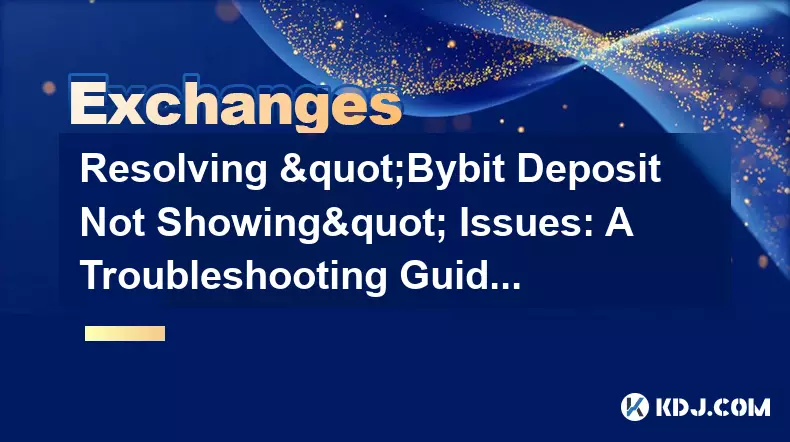-
 bitcoin
bitcoin $102182.982207 USD
-0.92% -
 ethereum
ethereum $3438.744518 USD
0.12% -
 tether
tether $0.999933 USD
0.02% -
 xrp
xrp $2.405093 USD
0.05% -
 bnb
bnb $956.306114 USD
-0.53% -
 solana
solana $153.028851 USD
-1.23% -
 usd-coin
usd-coin $0.999800 USD
-0.03% -
 tron
tron $0.294898 USD
-1.08% -
 dogecoin
dogecoin $0.171428 USD
-0.58% -
 cardano
cardano $0.551186 USD
-1.15% -
 hyperliquid
hyperliquid $38.755878 USD
0.04% -
 chainlink
chainlink $15.298460 USD
-0.05% -
 bitcoin-cash
bitcoin-cash $516.067428 USD
1.68% -
 stellar
stellar $0.280726 USD
-0.42% -
 zcash
zcash $518.919369 USD
18.01%
Resolving "Bybit Deposit Not Showing" Issues: A Troubleshooting Guide
Delays in Bybit deposits often stem from network congestion, incorrect wallet addresses, or insufficient transaction confirmations—always verify the network and TXID.
Nov 05, 2025 at 09:40 am

Understanding Common Causes of Delayed Deposits on Bybit
1. Network congestion can significantly delay transaction confirmations. When blockchain networks like Bitcoin or Ethereum experience high traffic, transactions with lower gas fees may take longer to be processed, leading to deposits not appearing immediately in your Bybit account.
2. Incorrect wallet address usage is another frequent issue. If a user sends funds to an incompatible network or uses a wrong destination tag, the deposit may fail entirely or get stuck in limbo without proper routing.
3. Bybit supports specific deposit networks for each cryptocurrency. Sending USDT via TRON (TRC20) instead of ERC20 when the deposit address was generated for ERC20 will result in the transfer not being credited.
4. Wallet synchronization delays sometimes occur between external wallets and exchange systems. Even after a successful blockchain confirmation, it might take additional time for Bybit’s backend systems to reflect the balance.
5. Insufficient transaction confirmations are a primary reason deposits don’t show up. Bybit requires a certain number of confirmations before crediting an account, and this varies by blockchain—Bitcoin typically needs six, while Ethereum-based tokens may require twelve or more.
Step-by-Step Verification Process
1. Log into your Bybit account and navigate to the “Assets” section, then select “Deposit History.” Check whether the transaction appears in the list, even if unconfirmed. This helps determine if the system has detected the incoming transfer.
2. Copy the transaction hash (TXID) from your withdrawal or sending wallet and paste it into a blockchain explorer corresponding to the network used—such as Etherscan for ERC20, Tronscan for TRC20, or Blockchain.com for BTC.
3. Verify that the TXID shows successful transmission and review the number of confirmations. If confirmations are below Bybit’s required threshold, wait until they are met before expecting the deposit to appear.
4. Confirm that the deposit was sent to the correct network type supported by the Bybit-generated address. Mismatched networks—even within the same coin, like USDT on BEP2 versus BEP20—will not be recognized automatically.
5. Contact Bybit support only after verifying all technical details. Provide them with the TXID, deposit address, amount sent, date and time of transaction, and screenshots of the blockchain explorer showing confirmation status.
Preventing Future Deposit Issues
1. Always double-check the network protocol before initiating any transfer. Bybit clearly displays acceptable networks next to each deposit address; ignoring these warnings leads to lost or delayed funds.
2. Use adequate gas fees when transferring tokens on congested networks. Setting too low a fee increases the chance of prolonged processing times or transaction failure.
3. Enable email or SMS notifications for deposit activity within your Bybit security settings. Immediate alerts help identify discrepancies quickly and initiate troubleshooting faster.
4. Maintain records of recent transactions including timestamps, addresses, and TXIDs. Having this data ready reduces resolution time when reaching out to customer service.
5. Avoid using intermediary wallets or DeFi platforms to route deposits unless you fully understand their impact on transaction metadata and compatibility with centralized exchanges like Bybit.
Frequently Asked Questions
What should I do if my transaction shows completed on the blockchain but isn't in my Bybit account?Ensure the correct network was used and check how many confirmations the transaction has received. If both are valid and the deposit still doesn’t appear after several hours, contact Bybit support with full transaction details.
Can I recover funds sent via the wrong network?In some cases, recovery is possible if the asset type and network are technically compatible and the deposit address exists on both chains. Submit a detailed ticket to Bybit support with proof of transaction to initiate investigation.
How long does it usually take for a deposit to appear after sending?Most deposits appear within 10 to 30 minutes. However, during peak network congestion or for blockchains with slower finality, such as Bitcoin, waiting periods exceeding one hour are normal.
Does Bybit charge for deposit transactions?Bybit does not impose fees on incoming deposits. Any charges incurred come from the blockchain network itself in the form of miner or validator fees, which are paid by the sender during the transfer process.
Disclaimer:info@kdj.com
The information provided is not trading advice. kdj.com does not assume any responsibility for any investments made based on the information provided in this article. Cryptocurrencies are highly volatile and it is highly recommended that you invest with caution after thorough research!
If you believe that the content used on this website infringes your copyright, please contact us immediately (info@kdj.com) and we will delete it promptly.
- Token Listing Mania: Attention Turns to BANK, MET, and the Rise of Meme Coin Utility
- 2025-11-14 01:00:01
- ZEC, Zcash, and Winklevoss: A New Chapter for Privacy?
- 2025-11-14 01:50:01
- Pi Network's Web3 Gaming Ecosystem: A New Dawn or Just Hype?
- 2025-11-14 01:20:01
- Decoding the Crypto Buzz: From SocialFi to Meme Coins, What's Worth Watching?
- 2025-11-14 01:30:02
- Hashgraph, Tokenization, and Hedera (HBAR): A New Era for Real-World Assets?
- 2025-11-14 01:10:02
- Lorenzo Protocol, Meteora Tokens, and Binance Listing: A New Era for Solana DeFi?
- 2025-11-14 01:35:01
Related knowledge

The Ultimate Guide to Bybit's Trading Competitions and Events
Nov 14,2025 at 01:39am
The Ultimate Guide to Bybit's Trading Competitions and Events Bybit has established itself as a leading cryptocurrency derivatives exchange, not only ...

Bybit Fees Explained: A Comprehensive Guide to Minimizing Costs
Nov 13,2025 at 09:20pm
Understanding Bybit's Fee Structure1. Bybit operates on a tiered fee model that differentiates between makers and takers in its spot and derivatives m...

Coinbase NFT Marketplace: A Beginner's Guide to Minting and Trading
Nov 13,2025 at 10:39pm
What Is the Coinbase NFT Marketplace?1. The Coinbase NFT marketplace is a digital platform integrated within the Coinbase ecosystem, allowing users to...

Binance Launchpad: An Insider's Guide to High-Potential Projects
Nov 13,2025 at 10:00pm
Binance Launchpad: A Gateway to Early-Stage Crypto Investments1. Binance Launchpad has established itself as one of the most influential platforms for...

OKX vs Bybit: A Head-to-Head Perpetual Swaps Comparison
Nov 13,2025 at 05:39pm
Trading Interface and User Experience1. OKX offers a sleek, data-rich interface tailored for both beginners and advanced traders. The platform integra...

Common Mistakes to Avoid on OKX: A Guide for New Traders
Nov 04,2025 at 03:37pm
Understanding the Interface Before Trading1. New traders often jump into placing orders without fully exploring the OKX platform layout. Taking time t...

The Ultimate Guide to Bybit's Trading Competitions and Events
Nov 14,2025 at 01:39am
The Ultimate Guide to Bybit's Trading Competitions and Events Bybit has established itself as a leading cryptocurrency derivatives exchange, not only ...

Bybit Fees Explained: A Comprehensive Guide to Minimizing Costs
Nov 13,2025 at 09:20pm
Understanding Bybit's Fee Structure1. Bybit operates on a tiered fee model that differentiates between makers and takers in its spot and derivatives m...

Coinbase NFT Marketplace: A Beginner's Guide to Minting and Trading
Nov 13,2025 at 10:39pm
What Is the Coinbase NFT Marketplace?1. The Coinbase NFT marketplace is a digital platform integrated within the Coinbase ecosystem, allowing users to...

Binance Launchpad: An Insider's Guide to High-Potential Projects
Nov 13,2025 at 10:00pm
Binance Launchpad: A Gateway to Early-Stage Crypto Investments1. Binance Launchpad has established itself as one of the most influential platforms for...

OKX vs Bybit: A Head-to-Head Perpetual Swaps Comparison
Nov 13,2025 at 05:39pm
Trading Interface and User Experience1. OKX offers a sleek, data-rich interface tailored for both beginners and advanced traders. The platform integra...

Common Mistakes to Avoid on OKX: A Guide for New Traders
Nov 04,2025 at 03:37pm
Understanding the Interface Before Trading1. New traders often jump into placing orders without fully exploring the OKX platform layout. Taking time t...
See all articles










































































